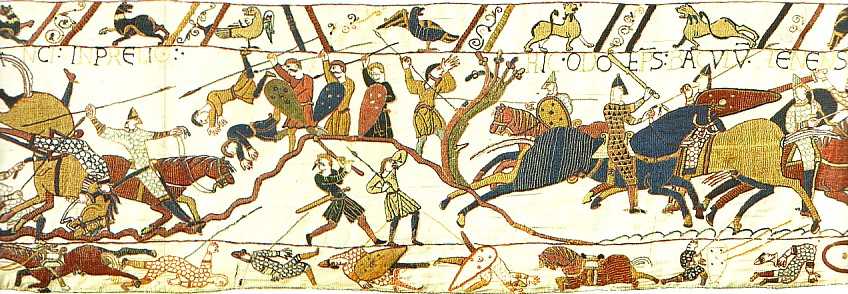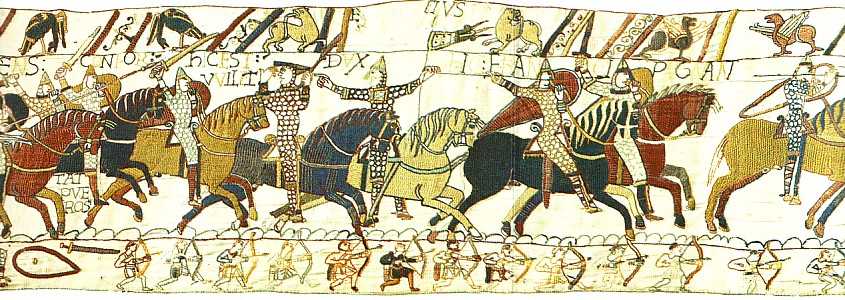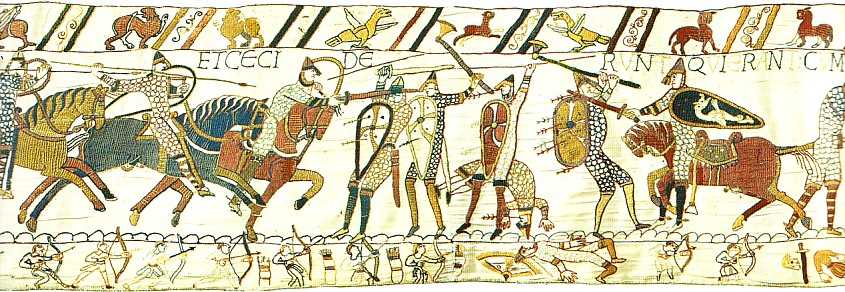
...IN BATTLE - HERE BISHOP ODO HOLDING A MACE...
A figure on foot at the left (with a spear) appears to be holding onto the girth strap of a falling horse. This figure must be a Norman, because you can discern (on a larger image) what appears to be a spur on his left heel. If he was intended to be English, his actions make no sense at all. I've thought this through and believe the Tapestry "libretist" was graphically showing an already dismounted knight doing his level best to prevent a comrade from also falling foul of the mucky ground. The futile absurdity of his actions is meant to be humorous.
The "rumpled" ground line, used to indicate the rough hillside, is gone when the marshy ground is depicted, but it is back again now, and rising up sharply in a singular battle scene. This has caused arguments, some scholars identifying this as the "hillock" standing out before the English right wing and north of Asten brook. (William of Malmesbury mentioned in his 12th century history that the English took possession of an "eminence" and caused severe casualties to the Normans: but he was probably using the Tapestry as one of his sources.) Others believe this scene is merely a self-contained depiction of the entire Battle hill position. All these cornered English troops are without armor, but none of them is rudely armed like the rustics of Kent and Sussex would be: the half-free husbandmen out to revenge themselves on the invaders for their pillaged homes. These warriors must be typical of the geneats (companions) who made up the retinues of thegns. They had horses to travel with and dismounted to fight just like their lords. Being armed servants, or holding part of a thegn's land, the geneats were the bulk of the fyrd (militia).
The "hillock" scene portrays the pockets of pursuing English who were cut off from the main army, surrounded and killed. Their dismay is evident as they face in every direction.
Bishop Odo is wearing that curious diamond-pattern garment over his full-length mail, and also wields a "baculum" which marks him as a high ranking officer. There is no evidence that he was any less warlike than his brothers. His figure is particularly well done and detailed - almost as if someone were trying to impress the bishop. This scene is during the "crisis" when the Normans had retreated.
William led cavalry to the support of the French right wing and together they finished off those men who had pursued the feigned flight. The Carmen says that Gyrth died here, slain by the duke's own hand. (Which would make Gyrth the likely commander of the English left - and by inference, that would place Leofwin in command of the right.) The Bretons fought amidst the marshy ground of Asten brook, and it appears that the last of the fighting was still going on there even after darkness had fallen.
...URGES ON THE YOUNG MEN - HERE IS DUKE WILLIAM - EUSTACE - HERE THE FRENCH ARE FIGHTING
I don't doubt that Odo had a hand in containing the rout and helping to restore order. Perhaps "young men" refers to new knights who were placed under Odo's personal command.
William is doffing his helmet to show his troops that he is alive. This scene plays the central part of the "crisis" episode, when William's fortunes were at their lowest ebb. Without his charisma and energy his army would have fled the field. "Eustace" (usually taken for count Eustace of Boulogne) points to the duke. The banner he holds is large and by far the most fancy: it is usually identified with the papal standard sent by pope Alexander II as a sign of the Church's favor, and the cross is a formy like that of the crusaders at the end of the century. Very early renditions of the Tapestry omit this figure's fine mustache, and it might be an addition during restoration.
There are different theories as to the identity of this figure, whose name is mostly missing in the border over his head; "Eustatius" (later Eustace) getting by far top billing. For a while, I advanced a theory that the actual name here was "Turstinus" (as given in Orderic Vitalis, later "Toustain" in Wace). After seeing the front side (at least) of the "flesh and blood" Bayeux Tapestry, I have to say that there is no evidence of a faulty restoration of the name as "Eustatius." And in Eustace of Boulogne's favor stands the Carmen account: wherein it is explained how he and William linked commands and fought together for the rest of the battle. It could have happened that Eustace took control of the papal banner for awhile. In any case, his name could have been later removed from the Tapestry for political reasons, perhaps relating to his subsequent rebellion and disfavor.
The archers in the lower border - all looking up at the main action - are clearly supporting the last attacks of the battle. Their "plunging fire" supposedly inflicted Harold's mortal wound in the face. At any rate the archers are heavily restored, and even the inscription here as well.
AND HERE THOSE HAVE FALLEN...
The last cavalry attack is boring in. The center, where the king stands surrounded by his elite housecarles, is all that remains of the English resistance. The shields are studded with arrows, testimony of the use of missile and shock that William understood so well. Another comical figure is the knight who has slipped forward right out of his saddle while landing a blow with his sword on a hoary-headed housecarle with an unusual oval shield. The Norman's helm has a huge nasal that looks rather ornate. The veteran housecarle fights on despite an arrow lodged in his mail coif, and he has the record number of arrows in a shield - five.
The knight on the black horse is using the four strap arrangement on his shield. The knight in front of him, cutting over his horses's ears with his sword, is an example of shoddy "week-end" work: note the off-rear leg, how it bends back at the knee like a front leg.
Harold was not the only one struck down by an arrow in the unprotected face, as two figures here are wounded in like manner, and a third is already dead in the lower border with an arrow in the eye. The English are definitely getting worsted by now.




